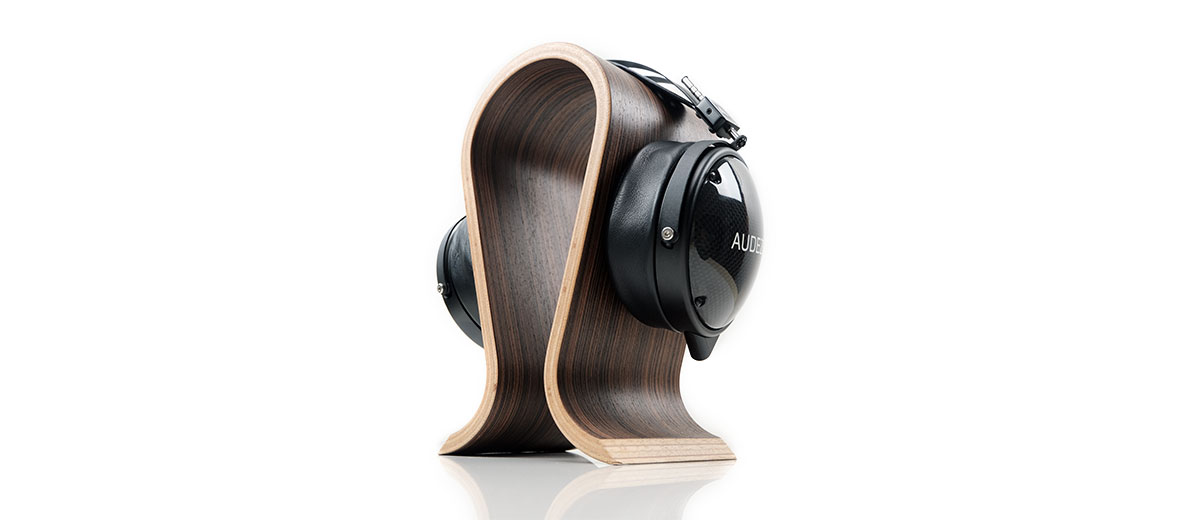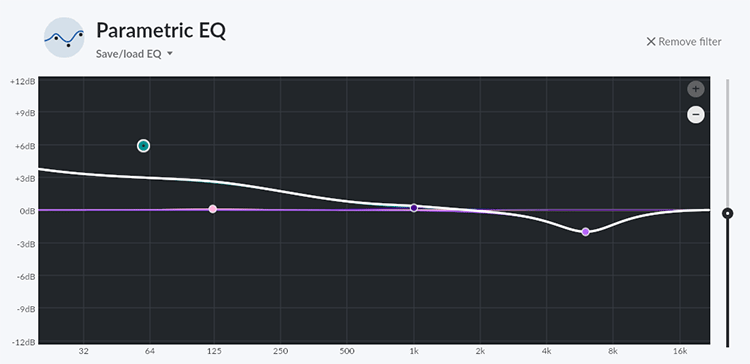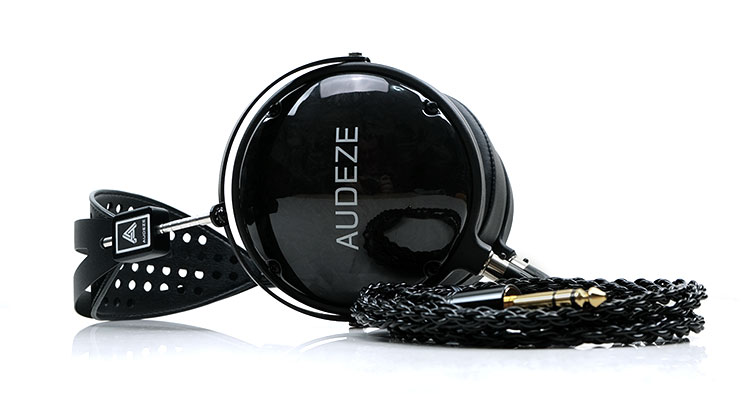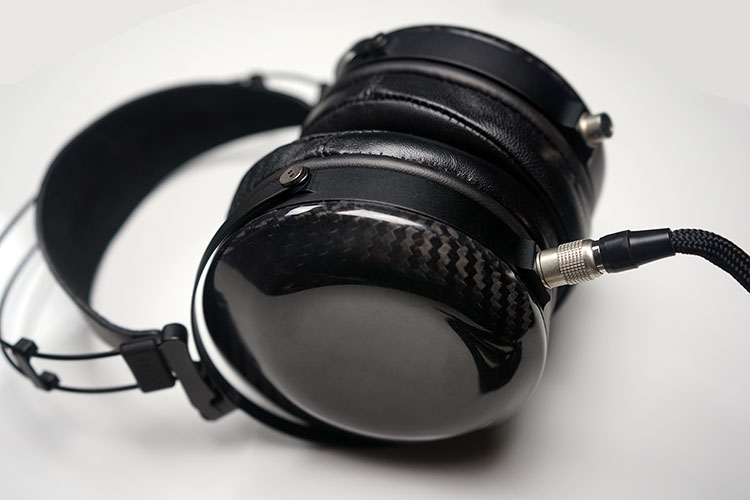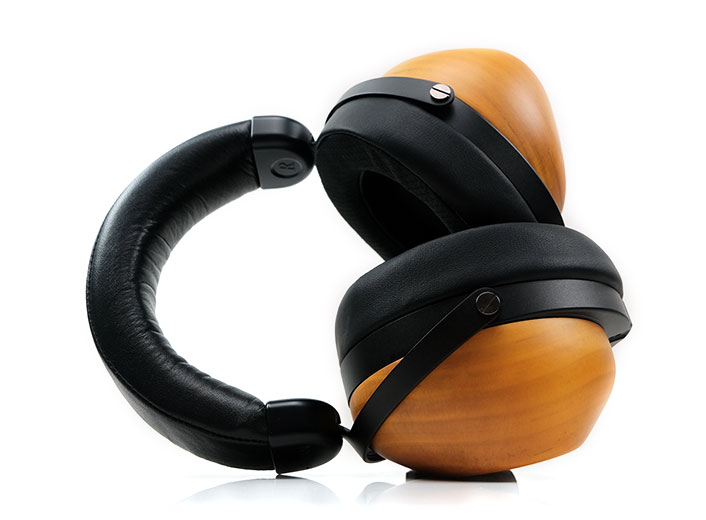Synergy
Efficiency
The LCD-XC 2021 is rated at 20Ω and 101dB SPL so it is not the hardest of planars to drive that are currently in the market today. It will sound livelier than the LCD-2 Closed-back but then you have to remember its higher 70Ω non-Fazor driver will require a little more power.
If you are using impedance selector capable amps such as the 2W capable Auris HA-2SF, then the Closed-Back sounds a lot better on the medium impedance switch rather than low whereas it is the reverse for the low impedance LCD-XC 2021.
Can you run it out of DAPs? Yes and no. The no applies to those who buy the Creator addition as you are stuck with a 1/4″ jack and you do need to go get a converter to 3.5mm for SE. You could buy the Professional Edition and go balanced with its additional XLR cable and a 4.4mm converter for better performance.
Get that sorted and the LCD-XC 2021 will happily run off a DAP from around 500mW upwards using a 4.4mm balanced output. Luckily, I happen to have an old but excellent ALO Audio Salty Pepper balanced cable with an additional 4.4mm converter and the XC 2021 ran fine on the DX300/AMP11 MK1 balanced output, even in low gain.
Even with less power, the 700mW capable LP P6 Pro sounded very sweet indeed using its balanced output with the LCD-XC 2021 so there are no issues there in terms of being driven from a portable source.
PMEQ
If you are a Roon user I would suggest avoiding using the Audeze LCD-XC preset as it is fashioned using the older model’s tuning.
The balance is not very good. You lose a lot of air and though there is some warmth through the lower mids it just sounds weird and boxy in the upper mids. Particularly so with female vocals which lose a lot of presence.
I would recommend moving instead to the PMEQ option and customizing your preferred sound. My personal preference is to focus on two areas, the sub-to-mid-bass response where I feel it’s a shade light, and the energetic 5-6k region.
I tend not to go overboard on the dB changes so I use a low-shelf around the 60Hz marker with a low Q of 0.2 so it’s linear rather than abrupt and a gain of around 6dB.
That should introduce a general lift to both the weight and warmth of the LCD-XC 2021 bass tuning from 20Hz to about 250Hz. In turn, you should hear a bit more of a fuller lower midrange timbre, a better fundamental for metal, and a slightly softer vocal tone.
I then take a peak filter and dip it by about 2dB with a narrow Q of 1.0 at 6k to pull down that treble energy a little.
I don’t want to mess around with the 1-3k peak because I do like a strong vocal but at the same time, it reduces a little of that odd-harmonic peak in the harmonic balance of both higher-pitched vocals and percussion such as cymbal crashes.
Desktop Pairings
If you wish to avoid EQ and play it as stock I found that a SET amplifier combined with a resolving punchy DAC was a better match than a clean solid-state setup.
This plays to my personal preferences but generally good quality amps such as the Auris HA-2SF delivered a bit more body and a slightly softer upper-mids and treble response to the LCD-XC 2021 than something like the Chord Hugo 2.
The Hugo 2 widened the LCD-XC 2021 staging for me compared to the HA-2SF but the low end was perhaps a bit drier, and shallower, and the top end a shade sharper. You get fantastic detail, and it does sound faster on the Hugo 2 but I prefer the weight and additional warmth from the Auris setup which was driven by the Chord Qutest DAC.
Somewhere in the middle are desktop amps like the Violectric V590 and the V281 which offer plenty of grunt and you can hear that additional slam right away with the LCD-XC 2021. More so the V281 which is one of the best for sub-bass reach.
The only issue with these two is the DAC of choice and here I would recommend going R2R to get a smoother upper-mids and treble response. The dual AK4490EQ inside the V590 is a little etched on the upper mids and treble for my liking with the LCD-XC 2021. Pre-amping the V281 will tease that out a bit more also.
However, bypassing and using something like the Musician Audio Pegasus R2R DAC produced a much smoother top-end response with the LCD-XC 2021.
Portable Pairings
That general smooth synergy recommendation also applies to DAPs. I do like how the DX300/LCD-XC 2021 pairs with AMP11 sounds with its analog-like tone and expansive soundstage. It can give a bit of emphasis to the vocal performance on the XC but the coloration is smooth enough to get away with it.
Going back to R2R on a DAP, however, is perfect for me with the LCD-XC 2021 pairing. Both the Luxury & Precision P6 and P6 Pro fleshed out some beautiful texture in those forward mids and introduced a bit more warmth on the low end. Treble remained very articulate but just a hint of softness on the leading edges made a big difference.
Select Comparisons
Audeze LCD-2 Closed Back
$899
Technical
We reviewed the cheaper LCD-2 Closed Back in March 2020 and in some ways externally it shares a lot of the same design DNA as the LCD-XC 2021. Internally, however, they are fairly different and represent a little of the past and the present Audeze.
Both headphones do share the same current Ultra-thin Uniforce™ 106mm diaphragm. However, the LCD-XC 2021 has the new stacked dual-sided Neodymium N50 magnet array and the 6 windows Fazor design. Whereas the Closed-Back is a non-Fazor implementation with the previous staggered Neodymium N50 magnet array.
Impedance on the Closed-Back is higher at 70Ω compared to just 20Ω on the LCD-XC 2021 though their SPL is roughly the same at 101dB SPL for the former and 100dB SPL for the latter. On paper, the LCD-XC 2021 should be the slightly easier of the two to drive.
In our real-world testing with the 2W (32Ω) Auris Audio HA-2SF we did find the Closed-Back required a tiny bit more current to match the same volume level as the LCD-XC 2021 on the low impedance setting or around 32Ω.
It did sound more dynamic and louder at the medium impedance setting whereas the LCD-XC 2021 dipped a bit but that just perfectly demonstrates the two headphones’ different impedance ratings for me.
Design
The LCD-XC does not use Noryl for the outer rings and the connector stems on the Closed-Back are integrated into the ring whereas the LCD-XC 2021 uses attached matte black finished mini-XLR stems.
The cups also have a slightly different design with the Closed-Back using that back base and brushstroke finish whereas the LCD-XC 2021 has the carbon fiber printed finish but both use the large Audeze white decal front and center.
The rest of the frame and form factors between these two are the same. That means the new thick angular pads, the wide gimbal composite arches with screws on both ends, pivot screws with blocks as well as an overarching headband with a pressure strap.
If you pick the leather-free option the pads and strap have a slightly different feel and finish with smaller mesh holes compared to the leather version. The leather-free pads also have a very slightly different feel to them compared to the leather options. I find the leather ones on the LCD-XC 2021 a bit more supple.
There is no difference in the cables, both are the same 1.9m 20AWG high-purity OCC copper wire in an SE termination. You will have the option to go balanced with the Professional Edition LCD-XC 2021 edition but no such option is available for the Closed Back.
Performance
Both of these headphones are quite spacious for closed-back designs but the tonal bias of both are quite different. With the LCD-2 Closed Back you will find your ears being drawn further down to the mids and bass response with a thicker warmer tone. Whereas with the LCD-XC 2021, it is more about the mids to treble and agility.
Without EQ, the LCD-XC 2021 200-500Hz scoop means its bass fundamental is not as weighty as the Closed Back. You will perceive it as agile, and articulate but not as physical or as warm and that does continue into the mids where both show very different performances.
The 2021 XC midrange is much more pronounced with vocals sounding vibrant and very much to the fore. The Closed Back has a relatively forward-sounding midrange but it’s not as pronounced and slightly smoother.
Vocals and higher pitching percussion on the XC are brighter in their timbre with less of a 4k dip you find on the Closed Back. The timbre on the Closed-Back is more forgiving but imaging a bit further back.
The treble on the Closed-Back is more elevated around 8-10k. You get a little bit of harmonic dissonance creeping in the mids, hence that 4k suck-out. On the XC it is more lower-treble focused with a fade into the upper treble. It has energy but not a brittle or ethereal effect on instrumental timbre.
For staging, the Closed-Back is thicker and more forward on the low end, and the LCD-XC 2021 is more forward in the mids to the lower treble, especially on vocals with a perceived improved headroom.
I think the XC is the more articulate of the two also for imaging with more contrast on spatial cues making them very easy to pick up.
Dan Clark Audio Ether C Flow (V1.1)
$1799.99
Technical
Though modifiable with the V1.1 kit the Ether C Flow has been largely unchanged since its launch in 2016 and Dan does still offer it as his flagship closed-back planar headphone to this day.
The sample we have here is the V1.1 modified version. It also still retails $500 higher than the LCD-XC 2021 though when it first came out the XC was priced almost the same.
The planar implementation on the Ether C Flow has a big focus on air management as opposed to the diaphragm thickness. Mind you, the LCD-XC 2021 also works its magic internally of airflow via its Fazor technology as well as moving from 8 to 6 ‘windows’ on this edition.
The Ether C Flow though is different with their use of their proprietary TrueFlow system, hence the name Flow. Their waveguide technology smooths the path for air moving into, through, and out of the magnet structure to reduce distortion and improve dynamics.
The DCA Ether C Flow also still uses its V-Planar technology combined with a dual-sided magnet array. This is a knurling variation on planar driver manufacturing to produce a concertina action on the diaphragm to improve stability and reduce nasty artifacts.
The equivalent on the LCD-XC 2021 is the Ultra-thin Uniforce™ 106mm diaphragm. However, the width of the conductor is variable to perfectly match the differing magnet strengths over various parts of the surface to get a more stable performance.
On paper, the Ether C Flow is the less efficient headphone at 23Ω and 92dB SPL compared to 20Ω and 101dB SPL. In our real-world testing on the HA-2SF, the LCD-XC 2021 was by far the more efficient headphones on the low impedance setting.
Design
DCA makes a big play on their planar headphones’ relatively lightweight design and it is indeed a big pro when compared to the LCD-XC 2021 at 390g compared to 677g. Considering both are full-sized circumaural headphones there’s a big gap and you will feel that difference during use.
The pressure distribution, however, is quite evenly balanced with both offering excellent displacement and neither showing up any uncomfortable hotspots or super tight clamping.
The LCD-XC 2021 thicker wedged leather pads are a big factor in their excellent balance. Isolation is relatively similar for both headphones as in above average and better than the HE-R10D.
As for the aesthetics and construction, they do differ, quite a lot in some places but both do offer a very similar carbon fiber front cup plate design. The slight difference is the more uniform dome-like design of the LCD-XC 2021 and the big Audeze decal in the middle.
A large part of the Ether C Flow’s weight reduction can also be attributed to the Nitinol headband which is very strong, flexible, and light. The LCD-XC 2021’s weightier powder-coated split spring steel headband, thicker leather, and more robust gimbal structure are the bulkier and heavier of the two.
The Hirose terminated VIVO cable comes as standard with the Ether C Flow. Some of the additional cost is probably here as it is a higher grade of cable over the stock LCD-XC SE cable.
On its own, it retails for $299 and is made of silver-plated OFHC copper at 2m in length compared to the mini-XLR terminated 1.9m 20AWG high-purity OCC copper wire of the LCD-XC 2021.
Performance
If we are talking purely timbre the Ether C Flow might be a more agreeable coloration with a slightly smoother quality through the lower mids. However, in terms of technical prowess and articulation, the LCD-XC 2021 has an edge for me.
The main factor behind this is the midrange tuning which has a lot of bumps and valleys on the Ether C flow and is a little more linear and balanced in the LCD-XC 2021.
Technically, both do shove the vocal further forward but it’s what’s happening on either side that robs the Ether C Flow of a bit of separation and presence compared to the LCD-XC 2021.
On the Flow, you get a bit of a dip from 1k to almost 3k, and a traditional 4k dip whereas on the XC the 1-4k curve is on a linear rise peaking around 3k. Save for an audible 5k blip, it has a nice fade to around 8-9k. As a result, this presence region sounds fuller and more vibrant on the XC and slightly hollowed out on the Flow with a little less air and instrumental separation.
On the very low end, the C Flow is the more physical and warmer of the two with more of an elevated sub-bass response.
The LCD-XC 2021 is the punchier of the two around the mid-bass region and does seem to display a slightly better transient response and dynamic range. The V1.1 Flow still has that 200Hz dip but it’s not as pronounced now as the original V1 version.
Both have a bit of a 5-6k bump which does throw in a little bit of harmonic dissonance on upper-mid timbre and a slightly etched quality to vocals. That might seem more pervasive on the LCD-XC 2021’s more forward tuning.
Hifiman HE-R10D
$1299
Technical
We reviewed the HE-R10D back in June of this year and it’s a dynamic closed-back headphone as opposed to planar. However, the price point of the HE-R10D is the same as the LCD-XC 20201 so worth a comparison.
The HE-R10D uses a 50mm dynamic driver with a rare earth magnet array and HIFIMAN’s patented Topology diaphragm for fined-tuning control. A very different driver system and a very different type of response, (see below in performance).
The LCD-XC 2021 is a planar magnetic driver design that uses a 106mm ultra-thin planar diaphragm with a dual-sided Neodymium N50 proprietary stacked magnet array and a 6-window Fazor design which helps guide the soundwaves in a smooth and controlled manner. This in turn improves phrase coherence and lowers potential ringing.
In terms of specifications, the HE-R10D is rated at 32Ω and 103dB which is a little stiffer in terms of resistance compared to the LCD-XC 2021 20Ω load but its SPL is more efficient by 2dB.
However, in our real-world test on the Auris HA-2SF at the low impedance setting, the Hifiman was a bit more efficient and easier to drive compared to the LCD-XC 2021.
Design
Very different aesthetics and form factors here with some pros and cons. The first pro is the weight with the HE-R10D much lighter at 370g compared to LCD-XC 2021 at 677g.
The LCD-XC 2021 has a better quality of materials used throughout, including carbon fiber, machines aluminum, and leather pads.
However, the HE-R10D is by far the lighter and comfier of the two headphones when on the head. The LCD-XC 2021 weighs in at a massive 677g or just over double the weight of the HE-R10D’s at 337g.
Now I do have to say that Audeze has done some wonderful things to mitigate that weight but the difference between the two is immediately noticeable. You will find the HE-R10D much more amenable to longer listening sessions.
Nevertheless, the new leather headphone adjuster strap and very thick but soft wedged leather pads do an excellent job of balancing the pressure distribution on the LCD-XC 201. There is a bias still to the cups given the size and magnet location but the strap displaces the vertical pressure very nicely.
The HE-R10D’s pressure displacement is excellent and whilst the pads are as thick they do not need to be with a somewhat more relaxed clamp and very little vertical or lateral pressure.
Performance
The immediate impression was that the midrange on the LCD-XC 2021 is a lot more forward and vibrant sounding than the HE-R10D tuning.
In terms of staging, that means the aspects of the instrumental imaging on the XC are a little further in the background whereas elements of the HE-R10D such as the mid-bass, lower mids, and upper treble are more pronounced and forward sounding.
The XC does have a lift from the lower mids from around 500Hz onwards which is classic Audeze tuning for me on the LCD range but it starts from a relatively controlled mid-to-upper bass so it does not sound as elevated and warm as the HE-R10D tuning.
The HE-R10D has a much stronger 500Hz to 1K bump which, combined with an elevated mid-bass presence delivers a punchier bass response. The LCD-XC 2021 extends beautifully and offers more sub-bass solidity and low-end clarity but beyond 70Hz it has that classic planar linear tuning so not as punchy.
The instrumental and male vocal timbre is to the softer and smoother side on the HE-R10D with a bit more treble contrast and energy creeping into the upper mids. Sibilance can creep into the HE-R10D’s female vocal range but it’s quite manageable.
The XC has a cleaner instrumental tone with better separation and less bass bloom. However, its 5-6k treble energy has less bass warmth to counter in its harmonic balance so the vocal timbre can sound cooler and drier overall.
Our Verdict
The LCD-XC 2021 evokes a similar pleasing impression as the LCD-2 Closed Back. That means a much better staging quality than you would expect for a closed-back headphone and excellent clarity throughout.
And yet, it is a different beast to the cheaper Closed Back with a decidedly more neutral cleaning tone, an uptake in perceived speed and articulation, and a general more midrange-focused bias. The bass extension is excellent but it is not the main focus here and not as thick sounding as the LCD-2 version.
You could argue that this is a headphone for those who like their female vocals front and center but there is more to the LCD-XC 2021 than that. There is energy in this performance and flexibility also to EQ to balance it for your personal preferences without it falling apart.
Should you get the Professional Edition? Debatable for the price jump if you have some good balanced cables anyhow and do not plan to be carrying it in a box everywhere with you. Is it still a heavy headphone? Yup, it is, no getting around that but the new designs and very comfy leather earpads help a great deal in getting the balance just right.
Overall, this is a unique tuning with a cleaner, vocal-centric performance for an Audeze LCD headphone, but also one very impressive closed-back planar headphone.
Audeze LCD-XC 2021 Specifications
- Style Over-ear, closed-back
- Transducer-type Planar Magnetic
- Magnetic structure Proprietary magnet array
- Phase management Fazor
- Magnet type Neodymium N50
- Diaphragm type Ultra-thin
- Transducer size 106 mm
- Maximum power handling 5W RMS
- Maximum SPL >130dB
- Frequency response 10Hz – 50kHz
- THD <0.1% @ 100dB
- Impedance 20 ohms
- Sensitivity 100 dB/1mW (at Drum Reference Point)
- Minimum power requirement >100mW
- Recommended power level >250mW
- Weight Carbon: 677g

